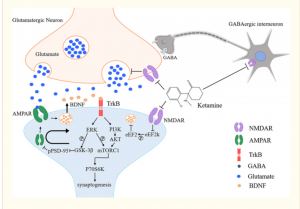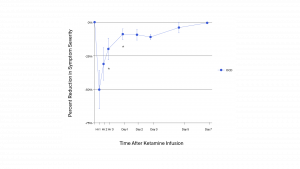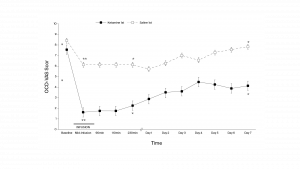The role of Ketamine in Obsessive-Compulsive Disorder

What we know so far
Obsessive-Compulsive Disorder (OCD) is a psychiatric disease characterized by the presence of both persistent, intrusive and repetitive thoughts (Obsessions) and repetitive behaviours (Compulsions).
It affects around 1-3% of general population and it can be highly debilitating when the time spent doing compulsions is greater than one hour per day (e.g., time spent washing hands, time consumed ordering objects, etc).
Psychotherapy and pharmacotherapy (antidepressants such as SSRIs and TCA) are the mainstream of the treatment; but in around 25% of the patients, it fails to revert all the OCD-symptoms.
During this last decade, Ketamine has been approved by both FDA and EMA to treat treatment-resistant Depression and it might be also applied to other psychiatric disorders, such as treatment-resistant OCD.
Ketamine is an antagonist of NMDA-receptors which can induce a massive release of BDNF (brain-derived neurotrophic factor), which in turn, is able to activate mTORC1 cascade and leads to synaptogenesis. This might restore a correct equilibrium of neurotransmitters (Dopamine, Noradrenaline, Serotonine).
Aim of the study
Our aim was to define whether Ketamine could be used to treat treatment-resistant OCD by investigating the literature (PubMed, Scopus, Google Scholar) available regarding this topic. To conduct this research “OCD” “ketamine” “Marble Burying Test” “Esketamine” “YBOCS” were used as keyword.
Progress and Prospects
The literature on this topic is still at its dawn, but both studies on animal models and humans showed a rapid and significant reduction of OCD-symptoms.
The images show the variation of YBOCS score (psychiatric scale for Obsessive-Compulsive Disorder) after a single administration of Ketamine; which is transient, but considerable.

(Bloch et al)

(Rodriquez et al)
Since the results are promising, the application of Ketamine in resistant-OCD deserves to be further investigated by new approaches (i.e., hIPCs disease modelling and other animal disease modelling) to fully understand the mechanisms of action.
Moreover, other human trials should be performed with larger samples of patients, repetitive administrations and long-term observation in a double-blinded set.
Acknowledgement: Massimo Clerici, Marcatili Matteo, Psychiatric Department, San Gerardo Hospital, ASST Monza; Prof. Ilaria Rivolta; Virgilio Program
Presented at: Poster Presentation at "Congresso Studentesco MoReMED - VI Edizione - 16th April 2021 and Oral Presentation at 9th Virtual MD/PhD Conference on April 22nd, 2021.
Federico Motta - Virgilio Program Student Psychiatric Department, ASST San Gerardo, Monza, Italy School of Medicine and Surgery Bicocca, Monza, Italy




